Lots of people looking to improve their eating think meal plans are the answer. The only problem? Meal plans usually suck… and they rarely last. So, instead of prescribing yet another doomed eating regimen, check out these 6 ways to transform any diet in a sustainable way.
++++
“Do I get a meal plan?”
This is the most common question we get from folks who are considering, or just started out in, our nutrition coaching programs.
The answer: No, we don’t do meal plans.
But we can’t blame people for asking.
Sure, meal plans have long been a staple of the fitness and nutrition industry. Coaches are taught to create them. Clients are taught to expect them.
Unfortunately…
Most of the time, meal plans don’t work.
You see, traditional meal plans are explicit prescriptions.
Eat this exact thing, in this exact amount, at this exact time.
For example, you’ll often see:
Breakfast – 7:30am
3 eggs, scrambled
1 cup vegetables
1 piece whole grain toast
1 cup coffee
1 glass water
Morning snack – 10:00am
1 protein bar
1 handful mixed nuts
Lunch – 12:30pm
4 oz chicken
2 cups salad
1 handful seeds
1 glass water
After exercise – 4:30pm
1 scoop whey protein
1/2 cup frozen fruit
1 tsp omega 3 oil
12 oz water
Dinner – 7:00pm
4 oz steak
1 cup cooked veggies
1 baked potato
1 glass water
You (or your clients/patients) might be thinking, “Good! I want a plan. I’m sick of trying to figure all this stuff out! Just tell me what to eat!”
Unfortunately, when we try to follow rigid prescriptions like this, lots can (and often does) go wrong.
For example:
Scenario 1: You just don’t stick to the plan.
No matter how enthusiastic you are, meal plans can be tough to follow.
This is normal. Life can get in the way.
- People get busy,
- we’re not always prepared,
- kids get sick,
- bosses expect you to work late,
- it’s always someone’s birthday (or a special holiday), and
- sometimes you just don’t feel like having a protein bar at 10am.
What’s more, even if you’ve actually paid to have someone make your plan, you might find yourself rebelling against it in subtle (or not-so-subtle) ways.
This is also normal.
Unfortunately, it means you might not get the results you hope for. For instance, a meal plan you hoped would help you lose weight could actually encourage you to gain weight instead.
Scenario 2: You follow the plan perfectly.
In fact, you follow it too well and for too long.
Most meal plans are meant to be temporary.
They’re designed to help a person get to a specific short-term goal, like dropping a few extra pounds before a wedding, learning to manage blood sugar, or cutting weight for an athletic competition.
Our bodies can usually adapt to a rigid way of eating for a short period of time.
But if you’re too strict for too long, you could wind up with disordered eating habits and lasting health (mental, metabolic, hormonal, etc) consequences.
Scenario 3: You follow the plan for a little while but it sucks.
It isn’t sustainable. It doesn’t make you feel better. It doesn’t keep you sane.
Maybe you see some short-term results (or not). But you hate living and eating this way. You never want to see another stupid piece of lettuce or 4 ounces of chicken.
Eventually, you get so turned off by the process that you regress or quit altogether. You conclude that “eating healthy” sucks.
And you miss your big chance to learn how to make healthier, more enjoyable, more lasting and real changes.
Another reason meal plans fail.
One of the biggest (yet generally unacknowledged) problems with traditional meal plans is their focus on “nutrients”.
Real people don’t eat “nutrients”. We eat food.
We eat meals, often with other people.
We eat meals that match our cultural background and social interests.
And we rarely measure things precisely.
Sure, sometimes an explicit prescription is necessary.
For instance, professional athletes or bodybuilders (in other words, people who make money off their bodies and athletic skills) use meal plans to prepare for training and competition.
A prescribed meal for someone in that situation might look something like this:
- 1/4 cup dry oats
- 3 oz turkey breast
- 1 cup steamed broccoli
- 5 almonds
- 1 omega-3 supplement
- 1 cup green tea (unsweetened)
But most of us don’t need that level of surgical precision.
We don’t normally eat “ounces” of things, or refer to food by their nutrients (like “omega-3 fatty acids”).
Instead, we eat foods like:
- hamburgers
- tacos and burritos
- salads
- pasta and noodles
- sandwiches, wraps, pitas and rotis
- stews and curries
- cereal and granola
- stir-fries
- casseroles
Bottom line: If you want to eat better, you don’t have to get weird about things.
You don’t need to weigh and measure everything, or count out your almonds.
Ask yourself: “Is someone paying me to do this?” If the answer is no, you likely don’t need this kind of approach.
You just need to think about what you’re already eating, and how you could make it a little bit better.
This means fiddling and adjusting.
Making small changes and improvements to what you already normally eat and enjoy, one small step at a time.
Think about a spectrum of food quality rather than “bad” or “good” foods.
Welcome to the meal transformation game.
When you play with the idea of a food spectrum or food continuum, you get to experiment with variables like:
- what you eat, and
- how you eat it.
Think of this as a game.
How can you play “make this meal just a little bit better” in every situation?
In which situations is that easier or harder?
When your choices are limited (for instance, when you’re traveling, or eating at a workplace cafeteria), how can you shoot for “a little bit better” while still being realistic, and without trying to be “perfect”?
(Hint for coaches: this is a great game to play with the people you work with.)
Let’s transform breakfast, lunch, and dinner.
Here’s how that “food spectrum” might look in daily life, with a sample day of eating.
Transforming breakfast
Stage 1
Let’s say that your go-to breakfast is a whipped-cream coffee drink and a chocolate croissant.
You pick it up in the drive-thru, and wolf it down on your way to work.
This is your starting point. It’s not “bad”. It’s just no longer working for you.
You’re getting indigestion from rushing, the croissant doesn’t hold you at all, and you’ve just spilled the coffee on your crotch while changing lanes.
Now your game is to improve your breakfast just a little bit, starting with what you already have or do.

Stage 2
Your opening moves in the meal transformation game:
- You might replace the croissant with a whole grain muffin.
- Instead of a “dessert in a cup”, you get a regular coffee with a single cream and sugar.
- You grab a yogurt cup on your way out of the house for a bit of protein.
Naturally, you’re still rushed and busy… so you eat your breakfast with some distractions, while scrolling through emails at work.
But this is a solid start. Well done.

Stage 3
Next level of game play:
- You switch the muffin to granola with cottage cheese or Greek yogurt.
- You switch the cream in your coffee for 2% milk. (Or even go right to black coffee, you meal player you!)
- You add some colorful fruit.
- You’re now eating out of dishes on a table, instead of out of takeout packages off the dashboard of your car.
Of course, you’re still checking out the news headlines while you eat…
No problem. We’re keeping it real.
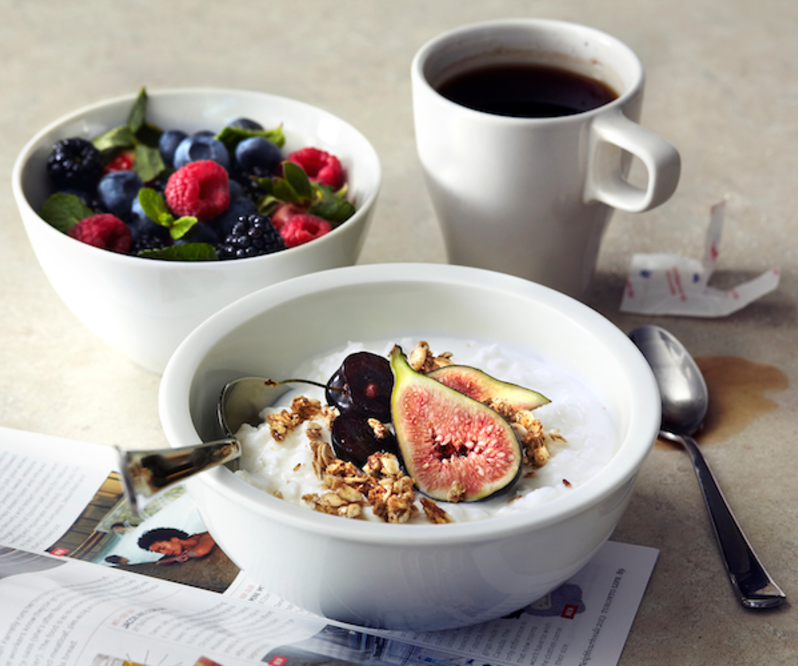
Stage 4
Now you are seriously playing like a pro.
- You’ve changed “rushing and panicked” to “set aside a little extra time to enjoy a leisurely breakfast”.
- You cleverly prepped an egg frittata with veggies in advance on your food prep day.
- The coffee’s become green tea, since you noticed that too much coffee was tweaking you out.
- The protein plus colorful fruit and veg have become the stars of the meal.
- You’ve discovered you really like lemon water. (WHAT? You don’t even know you anymore!)
- You eat mindfully, feeling relaxed, while watching the sun rise.
Ahhh.
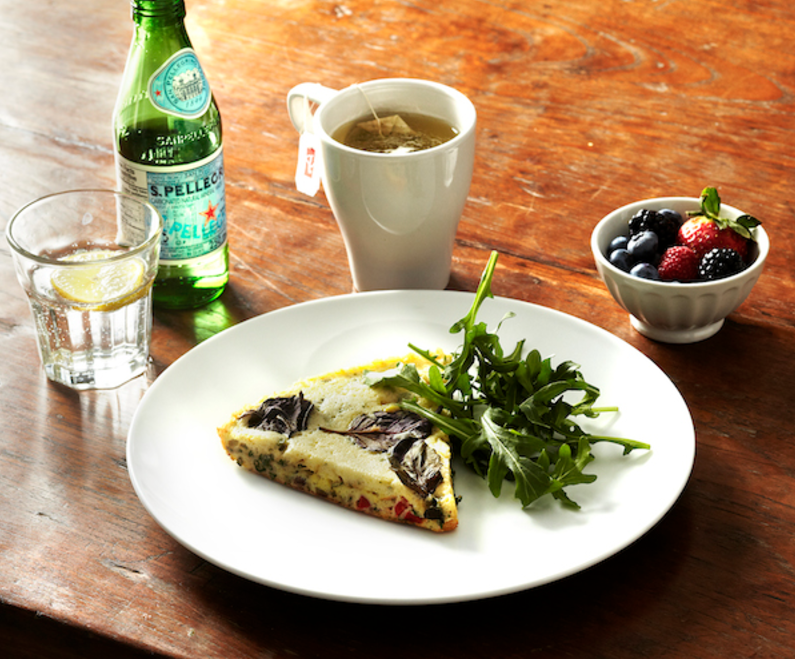
Transforming lunch
Stage 1
At this point, starting out, the idea of a sit-down lunch feels flat out ridiculous.
“Eat slowly? Who has time for that during a busy workday? Grab a burger and go!”
Another “car dashboard” meal. Another stomach ache and regret.
You decide you might want to play with this meal too.

Stage 2
To improve this meal a little bit:
- You go to a higher-end burger place where you’re pretty sure they use real meat.
- You get a side salad with that burger, and maybe just a few potato chips.
- You choose a diet soda instead of regular.
- You don’t eat in your car, but you do eat by your computer.
That’s OK. You’re progressing.

Stage 3
At this stage, you’re doing a little prep work:
- You whipped up some burgers in advance so they are handy and ready to take to work.
- You also grabbed some nice cheese and whole grain buns from the local market on shopping day.
For lunch, all you have to do is take your homemade burger and its fixins to work.
You still grab a diet cola from the vending machine to wash it down.
You move from your desk to the lunchroom, where you socialize with co-workers. This slows you down a bit and helps you digest and relax.

Stage 4
You’re having the burger without the bun, alongside a nice pre-prepped salad.
Instead of staying at your desk or in the office, you take a break.
You sit outside and get some fresh air while you enjoy your meal.
For a drink, water’s all you need.
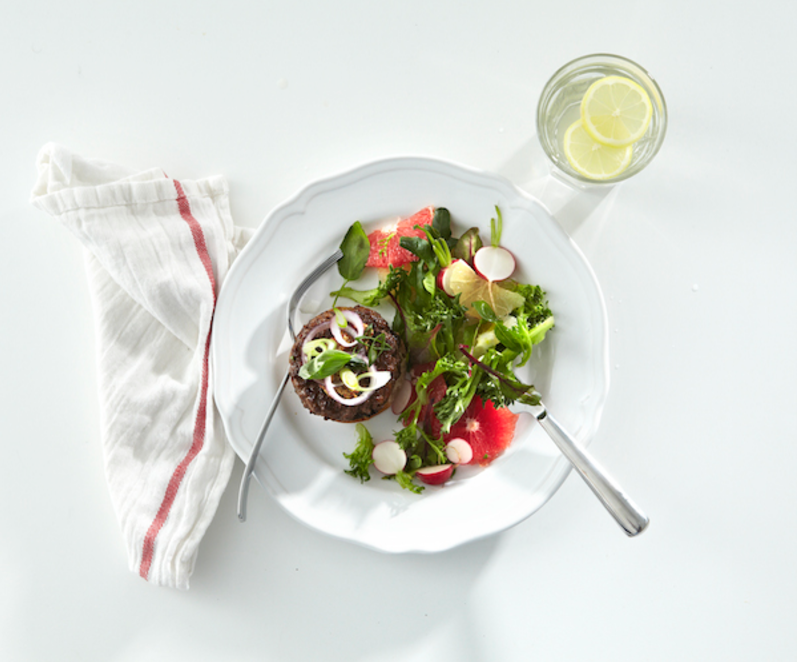
Transforming dinner
Stage 1
It’s 8pm. You’ve just gotten home after an insane day at work.
All you want to do is put food into your face and zone out in front of the TV.
You can’t even imagine making anything more complicated than boxed macaroni ‘n’ cheese right now.
Ketchup and hot dogs are as fancy as it gets.
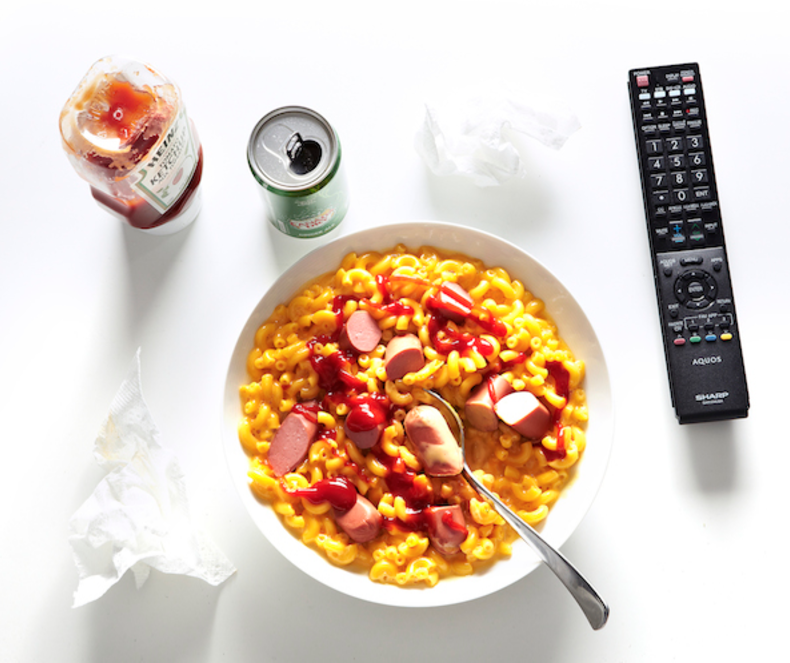
Stage 2
Same concept, but:
- You’re adding some extra protein with the help of a rotisserie chicken leg that you grabbed at the grocery store on the way home.
- You’ve added a side salad, just grabbing a few handfuls of pre-washed greens out of a bag.
- You’ve whipped up your own pasta.
Work is still on your mind, and a couple drinks will take the edge off.

Stage 3
Things are getting fancy.
- You’re upping the protein with a little more chicken.
- You’re having a little less pasta.
- You’ve also added a nice big salad to the mix.
- You’ve cut the booze to 1 drink.
Plus, you’re sitting at the dinner table, instead of flopping down on your couch or standing over the sink.

Stage 4
Again, we’re playing at pro level here.
With your meal planning and prep strategies, even a weeknight dinner looks good.
- You can whip up a delicious salad in 3 minutes flat and you have some pre-cooked quinoa on hand.
- That rotisserie chicken is still a fast, convenient option, but now it’s got some healthy buddies.
- You’re indulging in a single glass of good wine these days, and you take time to savor it.

Meal transformation is not about reaching perfection.
If you’re at stage 1, all you have to do is shoot for stage 2. Or stage 1.5.
If you’re in stage 2, play with getting to stage 3.
And if you’re stage 3, heck, you can stay where you are.
You might never get to stage 4. Or it might only happen at times when you’re relaxed and have a little extra time.
Stage 4 might only happen on Sunday night, whereas the rest of your week is a mix of stages 1, 2, and — if you’re super lucky — 3.
And that’s OK.
How far you progress along the continuum all depends on what YOU want, what YOU need, and what YOU can reasonably do, right now.
Over time, things can change.
Play YOUR game.
Success secret: Have a food prep ritual.
You might look at these photos and think, “How can people possibly do all that?”
One success secret: Having a food prep ritual.
The idea is simple:
Practice planning and preparing healthy food in advance.
This makes healthy eating convenient and easy.
It also makes decisions easier: You don’t have to make a choice when you’re rushed and hangry.
Your food prep ritual can include:
- shopping (or arranging to have food delivered)
- menu and meal planning
- washing and chopping vegetables
- cooking/preparing protein (e.g. cooking up some chicken breasts)
- cooking meals in bulk (e.g. casseroles, soups, stews, chili)
- preparing the dry ingredients for things like Super Shakes or healthy muffin mix
- soaking grains/beans beforehand so that they’ll be ready to cook later
- sorting foods into smaller containers or baggies
- freezing and refrigerating food for later
- planning healthy meals that someone else cooks (e.g. using a meal delivery service, deciding in advance what to order at a restaurant, etc.)
- looking ahead to ensure healthy eating strategies during the next few days, especially during difficult times (e.g. a busy week, traveling, dealing with a family crisis, etc.)
Mix and match any of these to find what works for you.
Experiment with systems, skills and strategies that work for YOU and YOUR life.
The real goal of a meal plan is to stop using a meal plan.
Fit, healthy people who have a good relationship with food don’t need other people to tell them exactly what to eat at all times.
Living a fit and healthy life doesn’t require perfection, either.
If you are using a meal plan:
That’s OK.
Some people like prescription, especially if they are working towards a specific short-term goal, like cutting weight to compete in wrestling, making sure they get enough nutrients to support a healthy pregnancy, or fueling their triathlon performance.
Keep it short-lived.
Meal plans are supposed to be temporary, working towards a short-term goal.
Keep it real.
As much as possible, try to make the meal plan fit your real life, not the other way around.
If you’re a parent, a worker, a student, or anyone else living in the real world, most of your meals will fall somewhere in the stages 1 through 3 spectrum. That’s perfectly OK. Just experiment with being a little bit better, wherever you can.
Remember all goals require trade-offs.
If you want to achieve a high level of performance or exceptional body composition, understand what you are prioritizing and sacrificing.
Getting very lean, for instance, comes with costs.
Make sure it’s working for you.
If your meal plan is making you feel:
- overwhelmed
- anxious and fretful
- guilty
- regretful
- bad
- overly rigid and/or preoccupied with food…
or any other negative, unproductive emotion…
…and if you find that meal plans result in you:
- “falling off the wagon”, hard
- getting obsessive and compulsive about food
- restricting foods and food groups, or
- doing “all or nothing”, usually ending with “nothing”
…then consider trying another approach.
What to do next
1. Consider where you sit on the spectrum of meal “stages”.
Where’s your food game at?
What level are you playing at?
What level would you like to play at?
Given your goals and your current situation, what is realistic?
For example, if you currently eat at stage 1, your goal might be to eat at stage 2 for most meals.
Or, if you eat at stage 3 most of the time but find yourself dipping into stage 1 or 2 meals more often than you’d like, aim to stay at stage 3 a little more consistently.
(Hint for coaches: you can walk people through these questions and help them arrive at their own answers.)
2. Start small. One step at a time.
Pick one meal to transform and focus on that.
For instance, you might leave all your other meals at stage 1, and focus on getting lunch to stage 2.
Concentrate on improving that one meal each day.
Using the examples above, you might think about things like:
- adding protein
- adding veggies or fruits
- eating less processed food
- eating more nutrient-dense, whole foods
- drinking less alcohol or fewer sweet drinks
- drinking more water
- eating in a calmer, more relaxed setting, and/or
- eating more slowly and mindfully
Of course, don’t try to do all these at once.
Try just fiddling with one or two, and see which ones work best for you.
3. Add things slowly.
Once you’ve improved one meal a day, try another.
If you feel like lunch is a solid stage 2 or 3, play with moving breakfast, dinner, or snacks along the spectrum.
Or, once you’ve improved one factor in a meal (e.g. adding more protein), try another.
For instance, if you’re getting more protein, now try switching out your sugary soda for some soda water. Or adding a little more veggies.
Be patient; small steps add up.
4. Set yourself up for success.
Notice what makes it easier and simpler for you to eat better.
Then figure out how to do or get more of that.
For instance:
- Is planning helping you? How could you do more of that?
- Is a healthy meal delivery service making it easy? Could you set aside a little more cash to get two meals a day instead of one?
- Is setting aside time on Sunday afternoon to cook some protein a good idea? Great, keep on doing that. Book it in your calendar.
There’s no “right” way to do this. Do what works for YOU.
5. Enjoy your meals.
Meal plans don’t usually address how you eat.
Before you change what you eat, you can also try changing how you eat. For example, you could:
- slow down
- breathe between bites
- relax
- savor your food
- sit at a table if you can, and/or
- use real dishes if you can.
Give yourself some time and space to appreciate those tasty concoctions you put together.
Meal time is YOUR time.
6. Work towards being your own boss.
Sometimes you might just want someone to tell you what to do.
That’s fine, and helpful, especially if you’re juggling a lot. But only for a while.
Over time, look for ways to help yourself intuitively and wisely make better choices, rather than just following the rules.
(Coaches, much more than serving up prescriptions, this is your job too: to help the folks you work with arrive at a place where they feel good about making decisions for themselves.)
Think long-term. What do you want to happen over the next few months? Year? 10 years? Do you want to be on a meal plan for the next few decades?
Today, if you were to take one small step towards the “better” end of the meal spectrum, what might that look like?
How can you start playing the “meal transformation game” today?
Want help becoming the healthiest, fittest, strongest version of you?
Most people know that regular movement, eating well, sleep, and stress management are important for looking and feeling better. Yet they need help applying that knowledge in the context of their busy, sometimes stressful lives.
Over the past the past two decades, we’ve used the Precision Nutrition Coaching method to help over 150,000 clients lose fat, get stronger, and improve their physical and mental health… for the long-term… no matter what challenges they’re dealing with.
It’s also why we work with health, fitness, and wellness professionals (through our Level 1 and Level 2 Certification programs) to teach them how to coach their own clients through the same challenges.
Interested in Precision Nutrition Coaching? Join the presale list now. You'll get a free gift today, save up to 54%, and have the chance to secure a spot 24 hours early.
We’ll be opening up spots in our next Precision Nutrition Coaching on Tuesday, January 14th, 2025.
If you're interested in coaching and want to find out more, join the presale list below. Being on the list gives you three special advantages.
- You’ll pay less than everyone else. Join the presale list and you’ll save up to 54% off the general public price.
- You’re more likely to get a spot. To give clients the personal care and attention they deserve, we only open up the program twice a year. By joining the presale list you’ll get the opportunity to register 24 hours before everyone else, increasing your chances of getting in.
- You’ll get a free gift—plus an inside look at the program. When you join the presale list today, we’ll send you a free 35-page ebook: Your Best Nutrition Starts Here—a complete guide to building a health plan for your body, goals, and lifestyle (no calorie-counting or restrictive dieting required). Plus, you'll get our new Enrollment Packet, giving you an inside look at the PN Coaching program, complete with stories from past clients who’ve overcome huge obstacles and achieved the transformation of their dreams, and more.
If you’re ready to change your body, and your life, with help from the world’s best coaches, this is your chance.
[Note: If your health and fitness are already sorted out, but you’re interested in helping others, check out our Precision Nutrition Level 1 Certification program].


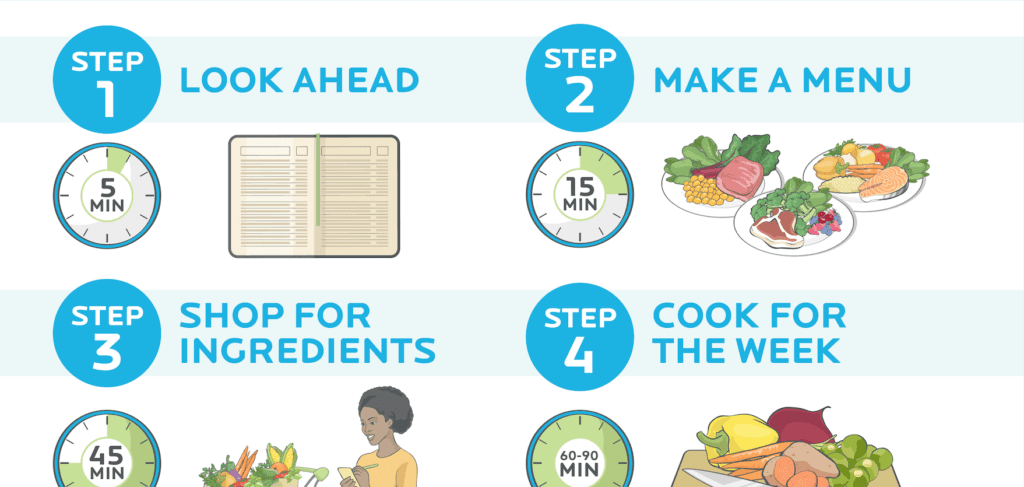

Share